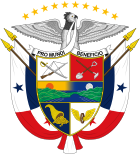The Constituent Assembly of Colombia was formed on February 5, 1991, to draft the Colombian Constitution of 1991. It was dissolved in July 1991, after the new document was adopted nationwide.

The Spanish transition to democracy, known in Spain as la Transición or la Transición española, is a period of modern Spanish history encompassing the regime change that moved from the Francoist dictatorship to the consolidation of a parliamentary system, in the form of constitutional monarchy under Juan Carlos I.

Enrique Adolfo Jiménez Brin was President of Panama from 15 June 1945 to 7 August 1948, representing the National Liberal Party of Panama.
The constitutional history of Colombia is the process of formation and evolution of the different constitutions that Colombia has had since its formation.

The Colombian Constitution of 1886 was the constitution that remade the United States of Colombia into the Republic of Colombia, and replaced the federal republic with a unitary state. Following the Colombian Civil War (1884–1885), a coalition of moderate Liberals and Conservatives, led by Rafael Nuñez, ended the political period known as "the Radical Olympus", repealed the Constitution of Rionegro (1863), and substituted it with the constitution of 1886. From then on, the country was officially known as the Republic of Colombia. The Constitution of 1886 was the longest lasting constitution in the history of Colombia, eventually being itself replaced by the Constitution of 1991.
Panama is a transcontinental country spanning the southern part of North America and the northern part of South America.

Panama is governed under the Constitution of Panama of 1972 as amended in 1978, 1983, 1993, 1994, and 2004. This is Panama's fourth constitution, previous constitutions having been adopted in 1904, 1941, and 1946. The differences among these constitutions have been matters of emphasis and have reflected the political circumstances existing at the time of their formulation.

Constitutional Assembly elections were held in Nicaragua on 6 November 1938.
The elections held on 6 November 1938 were even more of a sham than those that named Anastasio Somoza García president in 1936. The Conservatives decided to abstain again, while the ballot boxes and ballots were distributed throughout the country by the quartermaster general of the Guardia Nacional. The final results were made available within twenty-four hours. In 1938 the Genuino Conservatives decided to field candidates for the Constituent Assembly although the Conservative party’s leadership vehemently opposed the plan.

General elections were held in Panama on 10 May 1964, electing both a new President of the Republic and a new National Assembly.

General elections were held in Panama on 20 May 1960, electing both a new President of the Republic and a new National Assembly.

General elections were held in Panama on 13 May 1956, electing both a new President of the Republic and a new National Assembly.

General elections were held in Panama on 27 May 1948, electing both a new President of the Republic and a new National Assembly.

General elections were held in Panama on 11 May 1940, electing both a new president of the Republic and a new National Assembly.
The Socialist Party was a Panamanian left-wing political party created in 1933 by intellectuals and labor unionists who split off from the Liberal Party and rejected the Communist Party.
The National Patriotic Coalition was a Panamanian conservative nationalist political party.
The Renewal Party was a Panamanian right liberal political party.
The Popular Union Party was a Panamanian centrist liberal political party.
National Assembly elections were held between 21 and 23 November 1947 in China. They were the first elections under the newly ratified 1947 constitution. Under this constitution, the National Assembly was a constitutional convention and presidential electoral college. A total of 2,961 delegates were elected from across the country.
Esther Neira de Calvo (1890–1978) was a prominent educator, feminist and women's right advocate. She was the first woman elected as a National Deputy to the Third Constituent Assembly in Panama. She was the founder and president of the National Society for the Advancement of Women and of the Women's Patriotic League, and actively worked for Panamanian women's enfranchisement, finally attained in 1945–46. She served as Executive Secretary of the Inter American Commission of Women from 1949 to 1965 and was Panama's Ambassador to the Council of the Organization of American States from 1966 to 1968.

The Constitution of Costa Rica is the supreme law of Costa Rica. At the end of the 1948 Costa Rican Civil War, José Figueres Ferrer oversaw the Costa Rican Constitutional Assembly, which drafted the document. It was approved on 1949 November 7. Several older constitutions had been in effect starting from 1812, with the most recent former constitution ratified in 1871. The Costa Rican Constitution is remarkable in that in its Article 12 abolished the Costa Rican military, making it the second nation after Japan to do so by law. Another unusual clause is an amendment asserting the right to live in a healthy natural environment.






